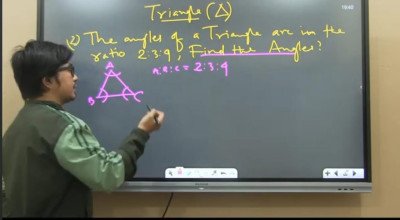Course description
Practical geometry involves the study and application of geometric principles to solve real-world problems and construct various figures accurately. Here's a breakdown:
Basic Geometric Elements: Practical geometry typically begins with understanding basic geometric elements such as points, lines, angles, and planes. These elements serve as the building blocks for more complex constructions.
Construction Tools: A compass and straightedge are the primary tools used in practical geometry. The compass is used to draw circles and arcs, while the straightedge is used to draw straight lines and measure distances.
Geometric Constructions: Practical geometry involves constructing various geometric figures using a compass and straightedge. Common constructions include perpendicular bisectors, angle bisectors, parallel lines, and various types of triangles and polygons.
Measurement and Calculation: Practical geometry often involves measuring lengths, angles, and areas of geometric figures. This may require the use of formulas and geometric principles to calculate these quantities accurately.
Applications: Practical geometry has numerous applications in various fields such as architecture, engineering, design, and art. It is used to design buildings, bridges, and other structures, create intricate patterns and designs, and solve real-world problems involving spatial relationships.
Problem-Solving: Practical geometry often involves solving problems related to spatial reasoning, symmetry, and congruence. This may include tasks such as finding missing lengths or angles, determining the congruence of geometric figures, or optimizing the layout of objects in a space.
Overall, practical geometry provides a framework for understanding and applying geometric principles to solve practical problems and create precise geometric constructions in various contexts
বাস্তব জ্যামিতি বাস্তব-বিশ্বের সমস্যা সমাধান এবং বিভিন্ন পরিসংখ্যান নির্ভুলভাবে নির্মাণের জন্য জ্যামিতিক নীতিগুলির অধ্যয়ন এবং প্রয়োগ জড়িত। এখানে একটি ব্রেকডাউন আছে:
মৌলিক জ্যামিতিক উপাদান: ব্যবহারিক জ্যামিতি সাধারণত বিন্দু, রেখা, কোণ এবং সমতলের মতো মৌলিক জ্যামিতিক উপাদান বোঝার মাধ্যমে শুরু হয়। এই উপাদানগুলি আরও জটিল নির্মাণের জন্য বিল্ডিং ব্লক হিসাবে কাজ করে।
নির্মাণ সরঞ্জাম: একটি কম্পাস এবং স্ট্রেটেডজ ব্যবহারিক জ্যামিতিতে ব্যবহৃত প্রাথমিক সরঞ্জাম। কম্পাসটি বৃত্ত এবং চাপ আঁকতে ব্যবহৃত হয়, যখন সরল প্রান্তটি সরলরেখা আঁকতে এবং দূরত্ব পরিমাপ করতে ব্যবহৃত হয়।
জ্যামিতিক নির্মাণ: ব্যবহারিক জ্যামিতিতে একটি কম্পাস এবং সোজা প্রান্ত ব্যবহার করে বিভিন্ন জ্যামিতিক চিত্র তৈরি করা জড়িত। সাধারণ নির্মাণের মধ্যে রয়েছে লম্ব দ্বিখণ্ডক, কোণ দ্বিখণ্ডক, সমান্তরাল রেখা এবং বিভিন্ন ধরনের ত্রিভুজ ও বহুভুজ।
পরিমাপ এবং গণনা: ব্যবহারিক জ্যামিতিতে প্রায়ই জ্যামিতিক চিত্রের দৈর্ঘ্য, কোণ এবং এলাকা পরিমাপ করা হয়। এই পরিমাণ সঠিকভাবে গণনা করার জন্য সূত্র এবং জ্যামিতিক নীতির ব্যবহার প্রয়োজন হতে পারে।
অ্যাপ্লিকেশন: ব্যবহারিক জ্যামিতির বিভিন্ন ক্ষেত্রে যেমন স্থাপত্য, প্রকৌশল, নকশা এবং শিল্পে অসংখ্য অ্যাপ্লিকেশন রয়েছে। এটি ভবন, সেতু এবং অন্যান্য কাঠামো ডিজাইন করতে, জটিল নিদর্শন এবং নকশা তৈরি করতে এবং স্থানিক সম্পর্কের সাথে জড়িত বাস্তব-বিশ্বের সমস্যার সমাধান করতে ব্যবহৃত হয়।
সমস্যা-সমাধান: ব্যবহারিক জ্যামিতিতে প্রায়ই স্থানিক যুক্তি, প্রতিসাম্য, এবং সামঞ্জস্য সম্পর্কিত সমস্যার সমাধান জড়িত থাকে। এর মধ্যে অনুপস্থিত দৈর্ঘ্য বা কোণগুলি খুঁজে বের করা, জ্যামিতিক চিত্রগুলির সামঞ্জস্য নির্ণয় করা বা কোনও স্থানের অবজেক্টের বিন্যাস অপ্টিমাইজ করার মতো কাজগুলি অন্তর্ভুক্ত থাকতে পারে।
সামগ্রিকভাবে, ব্যবহারিক জ্যামিতি ব্যবহারিক সমস্যাগুলি সমাধান করতে এবং বিভিন্ন প্রসঙ্গে সুনির্দিষ্ট জ্যামিতিক নির্মাণ তৈরি করতে জ্যামিতিক নীতিগুলি বোঝার এবং প্রয়োগ করার জন্য একটি কাঠামো প্রদান করে।



















